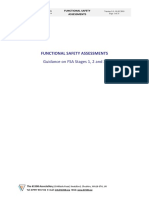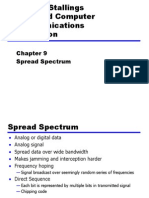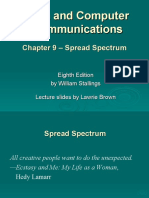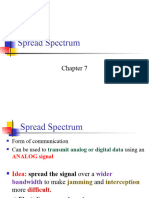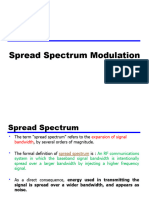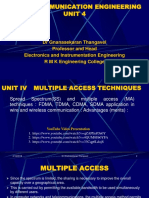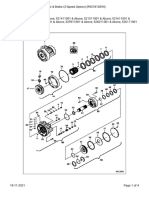0 ratings0% found this document useful (0 votes)
61 viewsLecture 7 - Spread Spectrum
1) Spread spectrum techniques spread data over a wide bandwidth to make jamming and interception more difficult.
2) There are two main spread spectrum techniques: frequency hopping spread spectrum (FHSS) which broadcasts a signal over different frequencies, and direct sequence spread spectrum (DSSS) which represents each bit with a code.
3) Code division multiple access (CDMA) is a multiplexing technique that allows multiple users to share the same frequency band using unique spreading codes, enabling signals to be separated at the receiver.
Uploaded by
Mohamed Mostafa elnahasCopyright
© © All Rights Reserved
Available Formats
Download as PDF, TXT or read online on Scribd
0 ratings0% found this document useful (0 votes)
61 viewsLecture 7 - Spread Spectrum
1) Spread spectrum techniques spread data over a wide bandwidth to make jamming and interception more difficult.
2) There are two main spread spectrum techniques: frequency hopping spread spectrum (FHSS) which broadcasts a signal over different frequencies, and direct sequence spread spectrum (DSSS) which represents each bit with a code.
3) Code division multiple access (CDMA) is a multiplexing technique that allows multiple users to share the same frequency band using unique spreading codes, enabling signals to be separated at the receiver.
Uploaded by
Mohamed Mostafa elnahasCopyright
© © All Rights Reserved
Available Formats
Download as PDF, TXT or read online on Scribd
You are on page 1/ 27
ECE461/ECE455 - SELECTED TOPICS IN
SIGNALS AND COMMUNICATION
SYSTEMS
LECTURE
Spread Spectrum
Dr. Fatma Newagy
Prof. of Communications Engineering
Fatma_newagy@eng.asu.edu.eg
Spread Spectrum
• Analog or digital data
• Analog signal
• Spread data over wide bandwidth
• Makes jamming and interception harder
• Frequency hoping
• Signal broadcast over seemingly random series of frequencies
• Direct Sequence
• Each bit is represented by multiple bits in transmitted signal
• Chipping code
Spread Spectrum Concept
• Input fed into channel encoder
• Produces narrow bandwidth analog signal around central
frequency
• Signal modulated using sequence of digits
• Spreading code/sequence
• Typically generated by pseudonoise/pseudorandom number
generator
• Increases bandwidth significantly
• Spreads spectrum
• Receiver uses same sequence to demodulate signal
• Demodulated signal fed into channel decoder
General Model of Spread Spectrum
System
Gains
• Immunity from various noise and multipath distortion
• Including jamming
• Can hide/encrypt signals
• Only receiver who knows spreading code can retrieve signal
• Several users can share same higher bandwidth with little
interference
• Cellular telephones
• Code division multiplexing (CDM)
• Code division multiple access (CDMA)
Pseudorandom Numbers
• Generated by algorithm using initial seed
• Deterministic algorithm
• Not actually random
• If algorithm good, results pass reasonable tests of randomness
• Need to know algorithm and seed to predict sequence
Frequency Hopping Spread Spectrum
(FHSS)
• Signal broadcast over seemingly random series of
frequencies
• Receiver hops between frequencies in sync with
transmitter
• Eavesdroppers hear unintelligible blips
• Jamming on one frequency affects only a few bits
Basic Operation
• Typically 2k carriers frequencies forming 2k channels
• Channel spacing corresponds with bandwidth of input
• Each channel used for fixed interval
• 300 ms in IEEE 802.11
• Some number of bits transmitted using some encoding scheme
• May be fractions of bit (see later)
• Sequence dictated by spreading code
Frequency Hopping Example
Frequency Hopping Spread Spectrum
System (Transmitter)
Frequency Hopping Spread Spectrum
System (Receiver)
Slow and Fast FHSS
• Frequency shifted every Tc seconds
• Duration of signal element is Ts seconds
• Slow FHSS has Tc Ts
• Fast FHSS has Tc < Ts
• Generally fast FHSS gives improved performance in noise
(or jamming)
Slow Frequency Hop Spread Spectrum Using MFSK
(M=4, k=2)
Fast Frequency Hop Spread Spectrum Using MFSK
(M=4, k=2)
FHSS Performance Considerations
• Typically large number of frequencies used
• Improved resistance to jamming
Direct Sequence Spread Spectrum
(DSSS)
• Each bit represented by multiple bits using spreading
code
• Spreading code spreads signal across wider frequency
band
• In proportion to number of bits used
• 10 bit spreading code spreads signal across 10 times bandwidth of
1 bit code
• One method:
• Combine input with spreading code using XOR
• Input bit 1 inverts spreading code bit
• Input zero bit doesn’t alter spreading code bit
• Data rate equal to original spreading code
• Performance similar to FHSS
Direct Sequence Spread Spectrum
Example
Direct Sequence Spread Spectrum
Transmitter
Direct Sequence Spread Spectrum
Transmitter
Direct Sequence Spread Spectrum Using
BPSK Example
Approximate
Spectrum of
DSSS Signal
Code Division Multiple Access (CDMA)
• Multiplexing Technique used with spread spectrum
• Start with data signal rate D
• Called bit data rate
• Break each bit into k chips according to fixed pattern
specific to each user
• User’s code
• New channel has chip data rate kD chips per second
• E.g. k=6, three users (A,B,C) communicating with base
receiver R
• Code for A = <1,-1,-1,1,-1,1>
• Code for B = <1,1,-1,-1,1,1>
• Code for C = <1,1,-1,1,1,-1>
CDMA Example
CDMA Explanation
• Consider A communicating with base
• Base knows A’s code
• Assume communication already synchronized
• A wants to send a 1
• Send chip pattern <1,-1,-1,1,-1,1>
• A’s code
• A wants to send 0
• Send chip[ pattern <-1,1,1,-1,1,-1>
• Complement of A’s code
• Decoder ignores other sources when using A’s code to
decode
• Orthogonal codes
CDMA for DSSS
• n users each using different orthogonal PN sequence
• Modulate each users data stream
• Using BPSK
• Multiply by spreading code of user
CDMA in a DSSS Environment
Seven Channel CDMA Encoding and
Decoding
You might also like
- Social Media Style Guide Template (To Use The Template, Click The - File - Tab and Select - Make A Copy - From The Drop-Down Menu)No ratings yetSocial Media Style Guide Template (To Use The Template, Click The - File - Tab and Select - Make A Copy - From The Drop-Down Menu)4 pages
- Simulation of Digital Communication Systems Using MatlabFrom EverandSimulation of Digital Communication Systems Using Matlab3.5/5 (22)
- FSA Guidance Document - As Published 08.03.2019 1.0No ratings yetFSA Guidance Document - As Published 08.03.2019 1.031 pages
- Spread Spectrum: By: Rahat Ullah Associate Professor CS - IT, SUIT PeshawarNo ratings yetSpread Spectrum: By: Rahat Ullah Associate Professor CS - IT, SUIT Peshawar26 pages
- Spread Spectrum in Spread Spectrum (SS), We Spread A Signal Over A Wide BandwidthNo ratings yetSpread Spectrum in Spread Spectrum (SS), We Spread A Signal Over A Wide Bandwidth9 pages
- Data and Computer Communications: - Spread SpectrumNo ratings yetData and Computer Communications: - Spread Spectrum26 pages
- Spread Spectrum: Presented By:-Ramjee Prasad 10804900 RH68T2B54No ratings yetSpread Spectrum: Presented By:-Ramjee Prasad 10804900 RH68T2B5424 pages
- Wireless Communications and Networks: William StallingsNo ratings yetWireless Communications and Networks: William Stallings24 pages
- Chapter 7. Spread Spectrum: Wen-Shyang Hwang Kuas EeNo ratings yetChapter 7. Spread Spectrum: Wen-Shyang Hwang Kuas Ee27 pages
- Chapter 7: Spread Spectrum: Frequency Hopping Direct Sequence Spread Spectrum Code Division Multiple Access (CDMA)No ratings yetChapter 7: Spread Spectrum: Frequency Hopping Direct Sequence Spread Spectrum Code Division Multiple Access (CDMA)40 pages
- Spread Spectrum: Submitted By: Vikas Sharma M.Tech (Part Time)No ratings yetSpread Spectrum: Submitted By: Vikas Sharma M.Tech (Part Time)19 pages
- Spread Spectrum and Pseudonoise SequencesNo ratings yetSpread Spectrum and Pseudonoise Sequences6 pages
- IE 419/519 Wireless Networks: Lecture Notes #6 Spread SpectrumNo ratings yetIE 419/519 Wireless Networks: Lecture Notes #6 Spread Spectrum25 pages
- Spread Spectrum Systems: Compiled By: Sanjay Kumar Chaudhary Be Elex & Comm-B-46-Iv/I 2065-01-31 Acme Engineering CollegeNo ratings yetSpread Spectrum Systems: Compiled By: Sanjay Kumar Chaudhary Be Elex & Comm-B-46-Iv/I 2065-01-31 Acme Engineering College25 pages
- Ec6651 Communication Engineering Unit 4No ratings yetEc6651 Communication Engineering Unit 436 pages
- Unit 5 - Mobile Communication - WWW - Rgpvnotes.inNo ratings yetUnit 5 - Mobile Communication - WWW - Rgpvnotes.in11 pages
- Wireless Communication: Spread SpectrumNo ratings yetWireless Communication: Spread Spectrum33 pages
- Bandwidth Utilization: Multiplexing and SpreadingNo ratings yetBandwidth Utilization: Multiplexing and Spreading26 pages
- Prepared By: Edwin Q. Deviza Jr. Bsece - 5No ratings yetPrepared By: Edwin Q. Deviza Jr. Bsece - 513 pages
- Spread Spectrum and Multiple Access T Chniqu S: UNIT-5No ratings yetSpread Spectrum and Multiple Access T Chniqu S: UNIT-530 pages
- Cisco_IT_Case_Study_Next_Generation_WirelessNo ratings yetCisco_IT_Case_Study_Next_Generation_Wireless10 pages
- LT-6014 FNC-2000 Fire Network Instr SheetNo ratings yetLT-6014 FNC-2000 Fire Network Instr Sheet1 page
- The Routledge Companion To Design Research by Rodgers, Paul A.yee, JoyceNo ratings yetThe Routledge Companion To Design Research by Rodgers, Paul A.yee, Joyce539 pages
- Category-I: Northern Region (Critical & Non-Critical)No ratings yetCategory-I: Northern Region (Critical & Non-Critical)26 pages
- Celonis Configuration Store Setup Guide 1.6No ratings yetCelonis Configuration Store Setup Guide 1.611 pages
- Btech Cs 5 Sem Computer Graphics kcs053 2022No ratings yetBtech Cs 5 Sem Computer Graphics kcs053 20222 pages
- Hydrostatic Motor & Brake (2-Speed Option) (R921810294) - S300No ratings yetHydrostatic Motor & Brake (2-Speed Option) (R921810294) - S3004 pages
- Photoelectric Vs Ionization Detectors - A Review of The LiteratureNo ratings yetPhotoelectric Vs Ionization Detectors - A Review of The Literature37 pages
- Social Media Style Guide Template (To Use The Template, Click The - File - Tab and Select - Make A Copy - From The Drop-Down Menu)Social Media Style Guide Template (To Use The Template, Click The - File - Tab and Select - Make A Copy - From The Drop-Down Menu)
- Simulation of Digital Communication Systems Using MatlabFrom EverandSimulation of Digital Communication Systems Using Matlab
- FSA Guidance Document - As Published 08.03.2019 1.0FSA Guidance Document - As Published 08.03.2019 1.0
- Spread Spectrum: By: Rahat Ullah Associate Professor CS - IT, SUIT PeshawarSpread Spectrum: By: Rahat Ullah Associate Professor CS - IT, SUIT Peshawar
- Spread Spectrum in Spread Spectrum (SS), We Spread A Signal Over A Wide BandwidthSpread Spectrum in Spread Spectrum (SS), We Spread A Signal Over A Wide Bandwidth
- Data and Computer Communications: - Spread SpectrumData and Computer Communications: - Spread Spectrum
- Spread Spectrum: Presented By:-Ramjee Prasad 10804900 RH68T2B54Spread Spectrum: Presented By:-Ramjee Prasad 10804900 RH68T2B54
- Wireless Communications and Networks: William StallingsWireless Communications and Networks: William Stallings
- Chapter 7. Spread Spectrum: Wen-Shyang Hwang Kuas EeChapter 7. Spread Spectrum: Wen-Shyang Hwang Kuas Ee
- Chapter 7: Spread Spectrum: Frequency Hopping Direct Sequence Spread Spectrum Code Division Multiple Access (CDMA)Chapter 7: Spread Spectrum: Frequency Hopping Direct Sequence Spread Spectrum Code Division Multiple Access (CDMA)
- Spread Spectrum: Submitted By: Vikas Sharma M.Tech (Part Time)Spread Spectrum: Submitted By: Vikas Sharma M.Tech (Part Time)
- IE 419/519 Wireless Networks: Lecture Notes #6 Spread SpectrumIE 419/519 Wireless Networks: Lecture Notes #6 Spread Spectrum
- Spread Spectrum Systems: Compiled By: Sanjay Kumar Chaudhary Be Elex & Comm-B-46-Iv/I 2065-01-31 Acme Engineering CollegeSpread Spectrum Systems: Compiled By: Sanjay Kumar Chaudhary Be Elex & Comm-B-46-Iv/I 2065-01-31 Acme Engineering College
- Unit 5 - Mobile Communication - WWW - Rgpvnotes.inUnit 5 - Mobile Communication - WWW - Rgpvnotes.in
- Spread Spectrum and Multiple Access T Chniqu S: UNIT-5Spread Spectrum and Multiple Access T Chniqu S: UNIT-5
- Analog Dialogue, Volume 45, Number 4: Analog Dialogue, #4From EverandAnalog Dialogue, Volume 45, Number 4: Analog Dialogue, #4
- Error-Correction on Non-Standard Communication ChannelsFrom EverandError-Correction on Non-Standard Communication Channels
- The Routledge Companion To Design Research by Rodgers, Paul A.yee, JoyceThe Routledge Companion To Design Research by Rodgers, Paul A.yee, Joyce
- Category-I: Northern Region (Critical & Non-Critical)Category-I: Northern Region (Critical & Non-Critical)
- Hydrostatic Motor & Brake (2-Speed Option) (R921810294) - S300Hydrostatic Motor & Brake (2-Speed Option) (R921810294) - S300
- Photoelectric Vs Ionization Detectors - A Review of The LiteraturePhotoelectric Vs Ionization Detectors - A Review of The Literature



